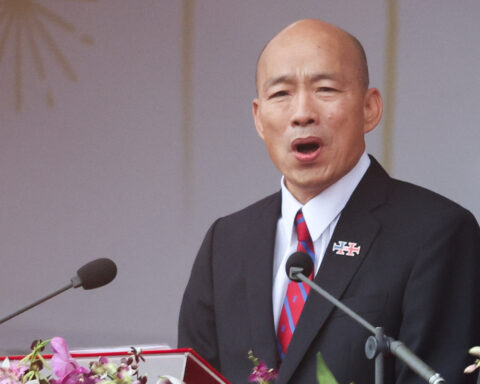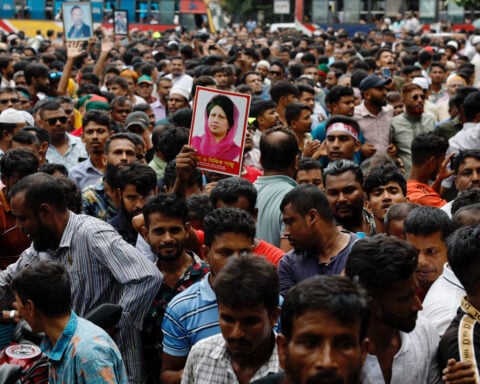WASHINGTON (AP) — Every seat in the New Jersey Legislature is up for grabs in Tuesday’s general election, but with solid Democratic majorities in both chambers, party control of the body is not expected to change hands.
Democrats have a 25-15 advantage in the state Senate and a 46-34 lead in the General Assembly.
Among the notable contests are the races in Legislative Districts 3 and 4 in southern New Jersey.
In District 3, which covers parts of Cumberland, Gloucester and Salem counties in the southwest, Republicans won the Senate seat and both Assembly seats by narrow margins in 2021. This year, state Sen. Edward Durr is running for reelection against Democrat John Burzichelli. For the Assembly seats, Republican Bethanne McCarthy Patrick is the lone incumbent in the race. The other Republican is Thomas Tedesco. The Democratic challengers are Heather Simmons and Dave Bailey.
District 4, which includes parts of Atlantic, Camden and Gloucester counties, features open-seat races for Senate and Assembly. The candidates for Senate are Democrat Paul Moriarty, Republican Christopher Del Borrello and third-party nominee Giuseppe Costanzo. The candidates for Assembly are Democrats Dan Hutchison and Cody Miller, Republicans Matthew Walker and Amanda Esposito and third-party hopeful Maureen Dukes Penrose.
The election for New Jersey governor will be held in 2025.
Here’s a look at what to expect on election night:
The general election in New Jersey will be held on Tuesday. Polls close at 8 p.m. ET.
The Associated Press will provide coverage for 78 races: 39 for the Senate and 39 for the Assembly. There are 40 legislative districts in New Jersey. Each district elects one senator and two members of the state Assembly. In the Assembly races, voters can vote for up to two candidates. Although seats are up in all 40 districts, some races are uncontested.
Voters registered in New Jersey may participate in the elections held in their districts. The deadline to register was Oct. 17. New Jersey does not allow Election Day registration.
The AP does not make projections and will declare a winner only when it’s determined there is no scenario that would allow the trailing candidates to close the gap. If a race has not been called, the AP will continue to cover any newsworthy developments, such as candidate concessions or declarations of victory. In doing so, the AP will make clear that it has not yet declared a winner and explain why.
In the last two general elections, about 10% of the total votes cast were tabulated after Election Day. This could delay race calls in competitive races. Most of the late-counted votes are mail ballots, which can arrive as late as Nov. 13 if they are postmarked by Election Day. Democrats in New Jersey are more likely to vote by mail than Republicans, as is the case across the country.
New Jersey does not have automatic recounts, but candidates and voters may request and pay for them. The cost of the recount is refunded if the outcome changes.
The AP may declare a winner in a race that is headed for a recount if it can determine the lead is too large for a recount or legal challenge to change the outcome.
As of Wednesday, there were 6.5 million voters registered in New Jersey. Of those, 39% are Democrats, 24% are Republicans and 36% are not affiliated with any party. The registration total in each of the state’s 40 legislative districts ranges from 111,000 to 197,000.
Turnout for the 2021 general election for governor was 40% of registered voters.
As of Wednesday, a total of 420,507 voters from across the state had cast ballots before Election Day, 63% from Democrats, 23% from Republicans and 14% from voters not affiliated with any party.
In both the 2021 and 2022 general elections, 30% of all votes were cast before Election Day.
First results are expected a few minutes after polls close, and election night updates are expected to conclude around 1 a.m. ET.
In the 2021 and 2022 general elections, 90% of votes were counted by noon the next day. In 2022, the vote count in some counties lasted an additional three weeks.
___
AP Decision Desk Editor Stephen Ohlemacher contributed to this report.

 Yellen defends COVID spending, says it saved millions from losing jobs
Yellen defends COVID spending, says it saved millions from losing jobs
 Futures flat on caution ahead of bank earnings, key inflation data
Futures flat on caution ahead of bank earnings, key inflation data
 Comoros ruling party wins parliamentary elections, opposition rejects results
Comoros ruling party wins parliamentary elections, opposition rejects results
 Sweden seeks to change constitution to be able to revoke citizenships
Sweden seeks to change constitution to be able to revoke citizenships
 Italy protests to Venezuela over arrest of NGO worker
Italy protests to Venezuela over arrest of NGO worker
 Euro zone's depressed industry records small rebound in November
Euro zone's depressed industry records small rebound in November
 Bayern Munich signs US youngster Bajung Darboe from LAFC
Bayern Munich signs US youngster Bajung Darboe from LAFC
 Novak Djokovic breaks a tie with Roger Federer for the most Grand Slam matches in tennis history
Novak Djokovic breaks a tie with Roger Federer for the most Grand Slam matches in tennis history
 China's RedNote: what you need to know about the app TikTok users are flocking to
China's RedNote: what you need to know about the app TikTok users are flocking to








